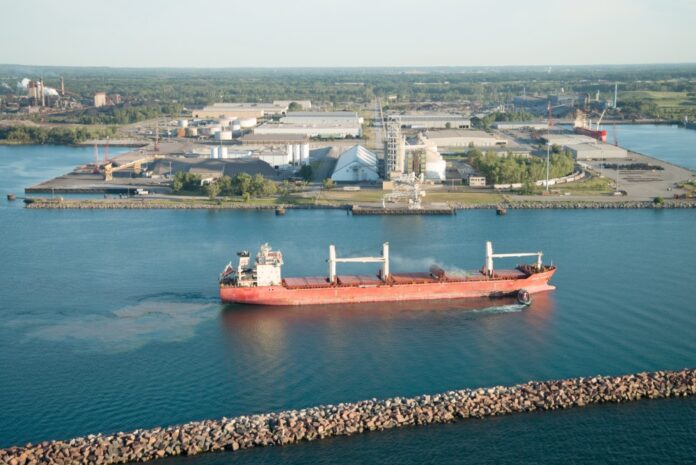
For the many ports on the Great Lakes, the St. Lawrence seaway is one of the most important lifelines for the border regions in the USA and Canada. Throughput has recently increased, and there is also news in the fleet development.[ds_preview]
The cross-border system is considered a major economic factor; along the 3,700 km route with 15 locks [ds_preview]lie numerous economic and industrial areas with a corresponding number of ports. A ship passing from Montreal to Lake Erie crosses the international border 27 times. The St. Lawrence Seaway Management Corporation (SLSMC) now announced that more than 38 mill. t. of cargo transited the system during the 2021 navigation season. »Despite another challenging year«, it was said, this was slightly above 2020’s results, namely by 0.99 %. The number of vessel transits rose by 1.61 % to 3,918.
Iron ore, steel slabs and other steel products accounted for 10.5 mill. t total, driven by demand from both the automotive and construction industries. Petroleum products and other essential chemical products were up some 5 %, »starting to return to more normal levels«. Such varied cargoes as stone, cement, potash and aluminium were also up. Grain, at 10.6 mill. t., was below 2020’s »exceptional results« due to a smaller crop and drought conditions in both western Canada and the U.S. mid-west. Canadian grain, however, was still tracking at a 5-year average.
Terence Bowles, President and CEO of the SLSMC, said: »In spite of the many challenges experienced by the transportation industry this past year, the Seaway was able to maintain its operations and its position as a reliable commercial transportation corridor, ensuring consistent and predictable service for its customers and supporting the Canadian and U.S. economies during this difficult period.« The region accounts for one-quarter of the U.S. gross domestic product (GDP), one-half of North America’s manufacturing and services industries, and is home to nearly one-quarter of the continent’s population.
Huge increase in biggest hub
The Port of Duluth-Superior – the biggest hub in the Great Lakes in terms of cargo throughput – has had a special year. Vessel arrivals jumped up more than 16 % compared to 2020.
»Rebounding from pandemic-induced lows in 2020, total maritime tonnage climbed to 32.9 mill. t in 2021«, the port announced. The result represented a 27 % season-over-season increase and a 2.3 % improvement over the five-season average.
Iron ore, the port’s leading cargo by tonnage, led the upswing. The total taconite float topped 20 mill. t for the second time in four seasons, a feat unmatched since the early 1990s. In all, 20.4 mill. t of iron ore transited Duluth-Superior, a 32.6 % season-over-season spike and 11.9 % gain on the five-season average. Driven primarily by Duluth-Superior’s first petcoke exports since the 1990s, the coal and petcoke category posted the biggest percentage increase compared to 2020, jumping 47 % to 7.9 mill. t.
At the Clure Public Marine Terminal nearly 50,000t of general cargo were handled, exceeding the 2020 count by 4.6 % and more than doubled the five-season average.
Container opportunities with MSC, too
However, Grain, the port’s No. 1 export, suffered a steep drop to 808,498 t, marking an 85-year low and the second lowest seasonal grain total for the port since 1890. Deb DeLuca, executive director of the Duluth Seaway Port Authority, said: »We’re still waiting on the return to normalcy, but the tonnage bounce back was pronounced, driven especially by strong demand for domestic steel.« She added, the port look sforward to playing an increasingly prominent role in 2022 »as we hopefully build on the bulk cargo tonnage and expand our containerized cargo services.«
As North America’s furthest-inland seaport, Duluth sees itself as »an attractive, uncongested choice« for shippers looking to move containerized cargo to and from America’s heartland.
»This idea of containers reaching the Midwest direct by water isn’t new,« said DeLuca. »It’s been part of the Clure Terminal vision since the mid-1960s, but the time is right to bring that vision into a modern focus, and we’re well positioned to do it«, hinting at the expanded maritime container capability now available at Duluth’s Clure Public Marine Terminal. The container shipping market saw the start of a new feeder service between Hamilton and Montreal in 2021. The docking of »Sedna Desgagnés« marked the first of what was expected to be an increasingly frequent service for container movements on the Great Lakes. The vessel was planned to carry approximately 350 TEU originating in the GTHA from Hamilton to Montreal, where they will be transloaded in Montreal to other vessels destined for various overseas ports.
In addition to Desgagnés and HOPA Ports, MSC was named as »a key supporter of this service«, Federal Marine Terminals as the terminal operator, and all export bookings handled by Hamilton-based freight forwarder Avancer International Freight Systems.
Another hub with major increases is the group of Ports of Indiana. They handled more than 11.2 mill. t in 2021, resulting in a 33.6 % increase from the hard-hit pandemic of 2020. Both Burns Harbor and Jeffersonville achieved their highest shipment to date.
Major cargo increases included a rebound in coal (213 %), salt (141 %), steel (40 %), grain (39%), minerals (23 %), oils (21 %) and limestone (20 %). Additional increases included coke and project cargo such as wind turbines.
On Lake Michigan, Burns Harbor handled 3.39 mill. t, up nearly 50 % compared to 2020. Limestone was up 92 %, steel shipments continued to grow by 67 %. However, project cargo, including wind turbines and mega storage tanks, was down compared to its best year in 2020, »but remained well above all other prior years«, it was said.
The port of Jeffersonville on the Ohio River handled 3.22 mill. t, up 21.6 %. Salt was up (59 %) from 2020, while grain was up (49 %), adding more than 1 million tons. Steel also increased (21.6 %). Also on the Ohio River, the port of Mount Vernon handled 4.65 mill. t, up 32 % from 2020. Coal shipments were up 241 %, especially in the third and fourth quarters meeting export demand, yet down considerably compared to prior years. Salt (143 %), minerals (73 %), grain (90 %), steel (32 %) and fertilizer (21 %) were all up in 2021.
Quick facts St. Lawrence Seaway
Ship types
- »Lakers«; built specifically for use within the St. Lawrence Seaway System and locks
- »Salties«: ocean-going vessels for overseas trade
- Pushed convoys: tug and a specially designed barge
Maximum vessel size
- 225.5 m (740 ft.) length
- 23.77 m (78 ft.) beam
- 8.08 m (26 ft., 6 in.) draught
- 30,000 tdw
Cargo types
- Grain
- Projects
- Iron ore
- Breakbulk
- Coal
- Liquid bulk
















